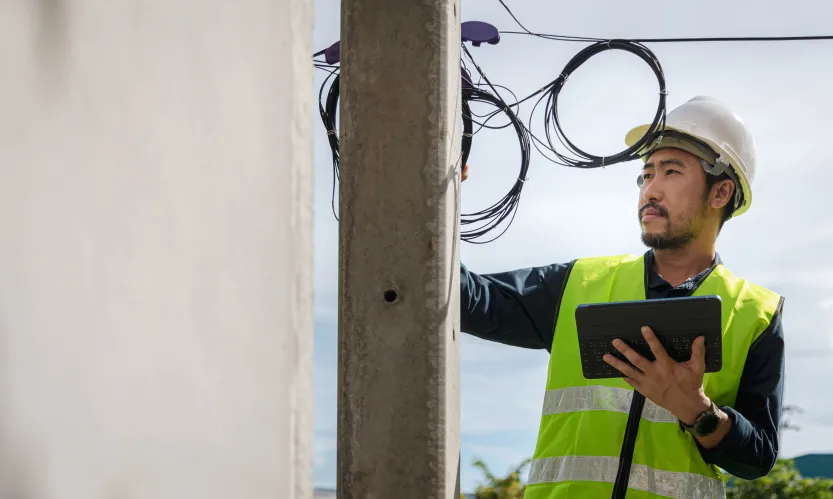What is First-Time Fix Rate (FTFR) and Why Does It Matter? In telecommunications, field service excellence is a key differentiator. Your ability to resolve customer issues quickly and effectively on the first visit directly impacts operational efficiency, customer satisfaction, and financial performance.
One of the central KPIs for field operation success is the First-Time Fix Rate (FTFR) , a critical metric that provides a clear view into the health of your field operations.
A high FTFR indicates your technicians have the correct skills, tools, and information to succeed. Conversely, a low FTFR signals underlying issues that lead to costly repeat visits, frustrated customers, and strained resources.
For telecom leaders, understanding and optimizing this metric is important for improving customer satisfaction, lowering costs due to rework and revisit, and achieve sustainable growth.
In this blog post, we'll go over:
What FTFR is and how to calculate it Why FTFR is an important success metric for field operations How your telecom teams can improve it Let's dive in!
Calculating First-Time Fix Rate The formula for FTFR is straightforward, measuring the percentage of work orders resolved on the initial technician visit without needing a follow-up.
The calculation is:
(Number of Work Orders Completed on First Visit / Total Number of Work Orders) x 100
For a work order to qualify as a "first-time fix," the technician must resolve the issue completely during the initial dispatch. Any subsequent truck roll for the same issue, whether by the same or a different technician, disqualifies it from this category. Accurately tracking this requires a clear definition of what constitutes a "resolved" ticket and a specific timeframe (e.g., 30 days) within which a follow-up visit is considered a repeat.
What should My FTFR Be? Industry benchmarks for FTFR in the telecom sector typically range from 75% to 85%, with 80% and above being considered excellent.
If your FTFR is below 80%, it indicates your field operations have significant operational inefficiencies which need to be addressed to lower costs and improve customer satisfaction. But regardless of what your FTFR is, improving it is always a good investment.
The Connection Between FTFR and Core Operational KPIs FTFR does not exist in a vacuum. It is deeply interconnected with other key performance indicators that define the success of your field service operations. Improving your FTFR creates a positive ripple effect across the entire service delivery chain.
Mean Time To Repair (MTTR): MTTR measures the average time from when a fault is reported until it is resolved. Repeat visits inherently extend this duration. A high FTFR reduces MTTR by ensuring issues are fixed correctly the first time, restoring service faster and minimizing customer downtime.Truck Rolls: Each truck roll represents a significant cost in fuel, vehicle maintenance, and technician labor. Repeat visits double or triple these expenses for a single issue. By increasing FTFR, you directly reduce the total number of truck rolls, leading to substantial cost savings.Service Level Agreement (SLA) Compliance: Telecom contracts are built on SLAs that dictate required uptime and response times. Failed first visits jeopardize these agreements, exposing your organization to financial penalties and reputational damage. A strong FTFR is essential for consistently meeting SLA commitments.Net Promoter Score (NPS) & Customer Satisfaction (CSAT): Nothing frustrates a customer more than having to schedule multiple appointments for the same problem. Successful first-time fixes create positive customer experiences, boosting satisfaction and loyalty. This translates directly to higher NPS and CSAT scores, which are powerful indicators of long-term customer retention.Revenue Protection: Every moment a service is down represents potential lost revenue for your customers and, in some cases, your own organization. Efficient repairs enabled by a high FTFR minimize service disruptions, protecting revenue streams and reinforcing your value as a reliable partner.Root Causes of a Low First-Time Fix Rate When FTFR declines, it is rarely due to a single cause. It is typically a symptom of systemic issues across people, processes, and technology. Identifying these root causes is the first step toward meaningful improvement.
Missing Documentation: Technicians who cannot quickly access OEM manuals, network diagrams, or site-specific historical data are at a disadvantage. Searching for information while on the clock extends repair times and increases the likelihood of errors.Knowledge Silos: Veteran technicians often possess immense institutional knowledge that isn't documented. When they are unavailable, other team members struggle to solve similar problems, leading to inconsistent outcomes.Poor and Slow Ticket Quality: Vague or incomplete work orders are a primary driver of inefficiency. When tickets lack structured data, photos, or a clear problem description, technicians are unprepared for the job ahead.Inadequate Diagnostics: Tickets lacking detailed diagnostic information force technicians to start from scratch on-site, wasting valuable time. If the initial problem assessment is incorrect, the technician may arrive with the wrong skills or equipment.Skills Mismatches: Dispatching a technician who lacks the specific expertise for a complex piece of equipment or a particular type of fault is a guaranteed path to a repeat visit. This often points to weaknesses in the triage and scheduling process.Parts Unavailability: A technician may correctly diagnose an issue but lack the necessary replacement part in their vehicle. This forces a follow-up visit, frustrating both the technician and the customer.How Can I Improve My Telecom's FTFR? Improving your First-Time Fix Rate requires a coordinated effort across your organization. A structured approach focusing on people, processes, and technology will yield the most significant and sustainable results.
People Closed-Loop Feedback: Create formal channels for technicians to report back on ticket quality, diagnostic accuracy, and knowledge base gaps. Use this field intelligence to refine processes and enrich training programs.Remote Expert Assistance: Implement tools that allow junior technicians to connect with senior experts via video call for real-time guidance. This "see what I see" support helps resolve complex issues on the first visit and serves as a powerful on-the-job training tool.Process Enhanced Triage and Ticket Quality: Standardize the information-gathering process at the point of service creation. Mandate the inclusion of structured data, error codes, and customer-provided details to ensure every ticket is actionable and sent to available staff. Dynamic Scheduling and Parts Staging: Align technician skills, geographic location, and parts availability with the specific demands of each job. Advanced scheduling systems can automate this process, ensuring the right person with the right equipment is dispatched every time.Technology Guided Diagnostics: Provide technicians with step-by-step troubleshooting workflows on their mobile devices. These guided procedures standardize the repair process, reduce guesswork, and ensure all necessary steps are followed.In-Field Knowledge Access: Equip your team with mobile access to a centralized knowledge base containing technical manuals, historical repair data, and best practice guides. This puts critical information at their fingertips, reducing the need to call for support.Improve your FTFR with Symphona AI Support Agents At SimplyAsk.ai, we're enabling telecoms today to improve their FTFR rates through our Symphona
Symphona’s AI Agents act as an on-the-job copilot for your technicians, integrating directly into their mobile workflow to drive efficiency and accuracy.
Intelligent Ticketing and Triage: Symphona automates the creation and assignment of highly structured and context-rich tickets. It allows technicians to quickly summarize customer descriptions, after which it uses keyword identification and intelligent assignment to send tickets (either through our own ticketing tool or your preferred ticketing software) to the best available personnel. Retrieval-Augmented Documentation: No more wasting time returning to the office to search for information. You can upload OEM manuals, past fix notes, and internal knowledge base articles to your Symphona AI Agents, so all your technicians have to do is simply ask for the information they need. Step-by-Step Guided Workflows: Equip your team with dynamic, step-by-step guidance on their mobile devices. Within your Symphona AI Agent, you can set up checklists and procedures, so technicians reduce the chance of missed steps that lead to repeat visits.Low FTFR is not a lost cause. All its causes are addressable through organizational planning and investing in the right tools. If you're looking for way to manage three main causes of low FTFR, our Symphona AI Agents for Field Operations can dramatically improve your telecom processes. Book a free consultation our other offerings for telecom.
.svg)

.svg)


.svg)





.avif)
.avif)





.svg)







.svg)

.svg)
.svg)
